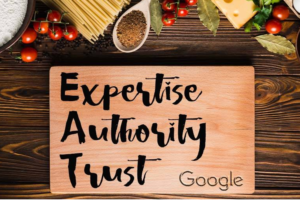Is Content Really King?
Yes … the phrase Bill Gates coined in 1996 still has legs a quarter of a century later. Creating amazing content can help not only in the SEO game but also in building loyalty and authority with prospective customers. So content should undoubtedly be part of your digital marketing and SEO strategy.
But whether content is truly “king” is debatable. When it comes to SEO, the reality is content is just one piece of the puzzle.
You can have an abundance of well-constructed, thought-provoking, original content, authored by industry experts, and still not be rewarded with a high enough ranking for it to be found on Google.
With billions of pieces of content produced daily, it takes more than great content to rise above all the noise. You need to know how to promote it. And you need to understand who you are trying to reach and what action you want them to take.
So while great content may be the foundation of an SEO campaign. It’s not enough. Content is the currency but it’s far from the only element of a winning strategy.
How to Turn Your Content into a Winning Strategy
Winning content isn’t always content that reaches Page 1 of Google. Yes, ranking high in Google SEPRPs for valued keywords can be a goldmine. But it isn’t the end goal. In most cases, the primary objective is to increase leads and sales.
With that in mind, here are some key elements that make up a winning strategy and comprehensive content plan.
1. Define Your Goals & Business
Your first need to figure out what you’re trying to achieve. Are you looking to drive revenue through your site? Or, build thought leadership and brand awareness? These will help you set some detailed goals and KPIs to measure the effectiveness.
And then you need to define who you are as a business. What pain points are you trying to solve? And how do you solve them better or differently?
Overlaying your audience’s pain points on top of your unique areas of expertise will help shape your content approach, the specific areas in which you’re the most knowledgeable and where you can add the most value.
2. Know your Audience Inside and Out
To ensure your content achieves the desired impact, its essential to know who your audience is and what type of content they prefer to consume.
Consider developing personas, or detailed profiles of each audience type you’re targeting. What are their interests? What are their problems? Where do they spend time online? How do they consume media? What are other preferences? Adding content just to rank for a certain key phrases is flawed and short-sighted. Adding great content that your target audience will truly benefit from is the approach that will drive traffic, leads and revenue.
3. Carve Out a Unique Perspective
Chances are your product or service is not the only one of its kind. And there’s probably already tons of related content that exists online. How can you make your content original, different and valuable?
You should try to either focus on niche topics or offer a different spin on more popular topics. Taking a contrarian viewpoint (if it’s authentic) can be a really effective way to stand out from the crowd. And as you develop your unique voice, keep your brand image and audience in mind. A whitepaper that targets C-suite executives should have a much different tenor than a video or blog post targeting recent college graduates.
4. Develop a Content Road Map
To be successful, your content plan needs to be actionable and consistent. That’s where a content road map or editorial calendar comes in.
Creating a documented schedule will keep everyone on task, organized and ensure a consistent flow of content. The first step is to select a calendar tool. You can use free tools like Google Doc or Excel, or there are several paid tools, with templates, that are worth considering. Airtable, Asana, and Monday are just a few of the paid providers.
Next, you’ll want to brainstorm ideas and create a list of topics that may or may not get produced. Then, outline the topics that make the cut with headlines and subheads and create a production schedule, detailing each stage in the process. After content is posted, assess it against your goals and tweak future topics based on the performance of past pieces.
5. Promote It
Given the multitude of channels, there is no single path to successful promotion. Maximizing reach usually means leveraging a variety of marketing platforms. Here are just a handful of tried-and true methods to increase visibility of your content.
- Guest Posting – Getting listed on the first page of Google (where more than 90% of SERP clicks take place) is no easy task. Earning links from high quality sites back to your site will tell Google your content is shareworthy and valuable enough to deserve attention. Guest posting is a powerful tactic where both the owner of the blog and the author publishing a guest post share cross-promotional value. The blog gets free top quality content and you benefit from the partnership through backlinks and authority sent back to your site. You want to focus on blogs/sites that produce high quality content and have good domain authority. It’s best to first establish relationships with industry bloggers – through commenting on their existing posts and email/social media outreach – before pitching your ideas.
- Social media – One of the easiest and most obvious ways to promote your content is through your social media accounts. Consistently sharing new content on Facebook, LinkedIn, Twitter, Instagram and TikTok, etc. is a great way to keep your audience engaged, generate shares and help you become a recognized authority. Boosting your post with a paid campaign is also an option. Since the cost can quickly add up, making sure you’re generating the right eyeballs and traffic (users that engage and convert) is essential with paid social media campaigns.
- Email – Often overlooked, email continues to be one of the most effective channels for content promotion. It does take time to build a subscriber list. But if you’re creating high-value content, your email list will continue to expand as you generate more traffic to your site. Remember, you want to make it as easy as possible for users to subscribe. Exit intent pop-ups with offers can help encourage more signups. And even though it may seem counterintuitive, inviting your fans and followers to subscribe can yield surprising results.
- Your Website – Make sure your content is highly visible on your site. Burying it under a small link in the header or footer won’t work. Ideally, it’s easily accessible in a section or feed on the Home page. On the blog page itself, you should highlight popular evergreen content at the top and related posts at the bottom.
6. Measure, Assess and Refine
To understand what’s working and what isn’t, your content marketing must be measurable. Content marketing metrics generally fall into one of four categories: consumption, engagement, lead/inquiry generation and sales.
Once you define your KPIs, you’ll have a clear map of your content goals and how success is defined. Then, you’ll know how your content is performing relative to goals and benchmarks.
Finally, you can use that data to modify your strategy and reassess your approach with future content.
While its true great content is vital to ranking high on Google, you likely won’t rank on content alone. Develop a winning content strategy for search or broader-based marketing goals requires a comprehensive plan, covering the production of the content itself, how and where it will be promoted, and what results it is designed to achieve.
It won’t happen overnight, but when done correctly the payoff from an effective content marketing campaign can be a king’s ransom for your business.
Related posts:
Categories:


